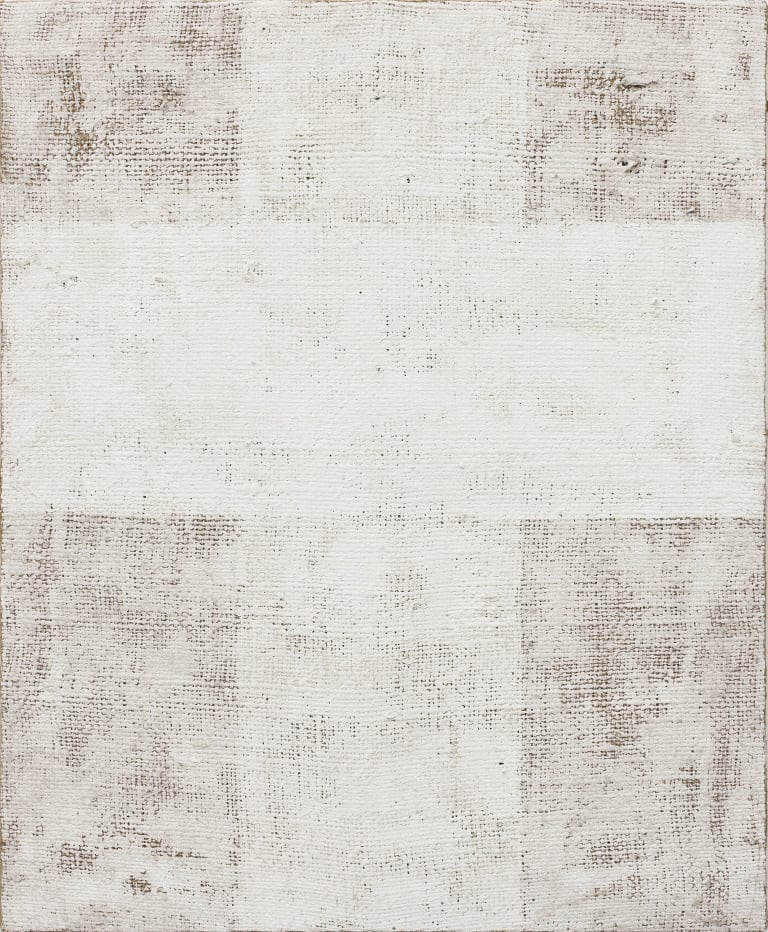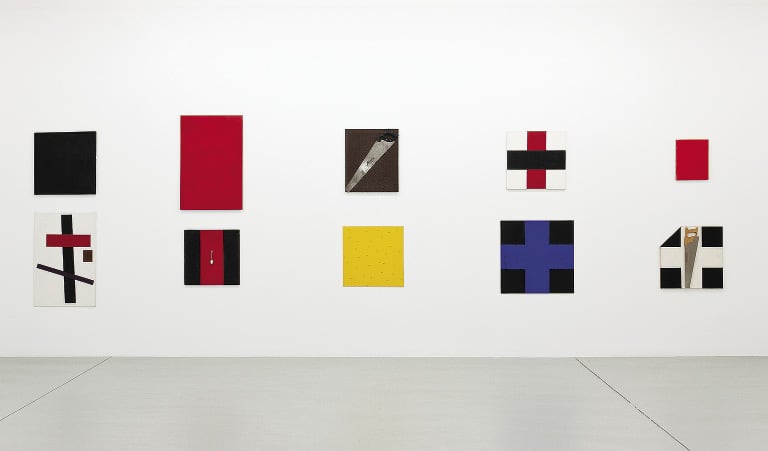
John Nixon
John Nixon: Paintings and Drawings 1979–1993
KalimanRawlins
7–28 July 2012
John Nixon: Paintings and Drawings 1979–1993, held in July at KalimanRawlins gallery in South Yarra, provided an important opportunity for many — especially the younger generation of artists, curators and critics for whom Nixon is something of a cult figure in the Melbourne scene — to view en masse the artist’s work from the fifteen years addressed in the exhibition. This was in no sense, however, a sweeping overview of Nixon’s work from the period in question. Indeed, the exhibition was striking for its total refusal of the historicising function common to (or constitutive of) the genre of the retrospective, in which individual artworks serve to illustrate a narrative of individual artistic development. Instead, the evenly spaced hanging of the fifty-eight paintings and the serial distribution of the forty-eight works on paper signalled, first of all, a complete disregard for the works’ provenance, and secondly, a reluctance to confer significance onto individual works over others.
If the rationale governing the exhibition design was more or less self-evident, the reason behind the chronological framing of the retrospective was somewhat less clear. Granted, 1979 marks the year Nixon founded Art Projects in the Melbourne CBD, the artist-run space that would operate for the following five and a half years as the headquarters for the local experimental visual arts community. But it was in 1978, shortly after his return from a six-month stay in London, when Nixon finally abandoned the analytic conceptualism he had practised since 1970 and resumed the production of visual art. That the artist himself retroactively designates 1978 as the origin of his ongoing Experimental Painting Workshop (EPW) is evidence of the importance he too attaches to this year. Out of a sense of historical completeness, then, it perhaps would have been appropriate to reflect, in the enclosing dates of the retrospective, this moment of substantial artistic reorientation. This minor criticism might, however, seem somewhat unjustified in light of the fact that Nixon’s selection of works was limited to those that were available in his storeroom, for in this respect the curatorial criteria were entirely in keeping with the spirit of ad hoc pragmatism in which the works had initially been produced.
The majority of the paintings included in the retrospective derived from the compositional templates of the Cross, the Square or the Monochrome; variations between works of the same template derived principally from alterations in size, colour, and materials. As is always the case with Nixon, the paintings were exempted from the task of illusionism, conforming instead to what might be described in terms of a logic of self-manifestation, in which the material resources out of which each was constructed were called upon to show themselves in a state of nakedness. This logic motivated the series of acute textural contrasts within separate works: for example, in Purple monochrome 1990 between the stack of thick warped cardboard, visible only from a side angle, and the smooth layer of purple enamel paint on its front. In Yellow monochrome 1987, it governed the scattering of the straw stalks across the cleanly painted surface of the rectangular Masonite support. The beauty of these stark formal economies derived in part from their rendering foreign to perception materials that are both easily identifiable and commonly available.

While the paring back of composition was harnessed towards the disclosure of raw materiality, it also served the related function — equally important to Nixon — of declaring the labour of the artist in the finished artwork. This declaration of ‘worked-on-ness’ echoed throughout the retrospective, and it was arguably exaggerated in those paintings to which various implements (including a drill, mallets, rulers, and saws) employed in the production process had been attached. It found an exemplarily crisp and understated expression, by contrast, in White cross 1989. Unlike the eleven other Cross works included in the retrospective, the figure and ground of White cross were rendered in the same white acrylic paint, which meant that their identity as such was articulated only through the relation set up between the even coating of the Cross, on the one hand, and the scuffed patchiness of its background, on the other. And within the Cross itself, a further partitioning could be observed in the direction and layering of the brushstrokes, which indicated that the vertical bar had been completed prior to the slightly bowed horizontal. Nixon’s assortment of paint application techniques also served to accentuate the roughness and inconsistency of the loosely woven hessian canvas support, whose outermost threads caught more paint than those more tightly knotted into its structure. In this way, the sculptural prominence of the picture support in White cross came to quietly oppose the primacy of the figure-ground relation.
As noted above, recurrent throughout the exhibition were the forms of the Cross, the Square, and the Monochrome. These forms are, of course, emblematic of Russian Suprematism. Due to his tendency to wear his influences on his sleeve, it is understandable that Nixon’s critics, advocates as well as detractors, have often questioned the nature of his debt to his predecessors. On this topic, avant-gardist critics argue that while Malevich understood his Black Square 1915 as a ‘zero-point of form’, an expression of pure feeling constitutive of a leap beyond the shackles of history, it is impossible to view its reprisal in Nixon’s Black square 1979, over sixty years later, outside the long shadow cast by the original. The argument runs that there is a fundamental contradiction in Nixon’s claiming inheritance to a tradition premised on the abolition of all forms of inheritance, and that therefore his practice is at best a monumentalising gesture, and at worst a tokenistic revival of a formal device purged of its original emancipatory intent. The postmodernist critic understands the same tokenistic revival instead in terms of a self-conscious meditation on the death of the avant-garde, and thus as a redeeming critical aspect of his practice. Nixon is aligned, from this perspective, with the host of painters working in the late 1970s and early 1980s (including in the Australian context Arkley, Clark, Davila, Tillers, and Watson) who conceived of the strategies of appropriation and quotation as central to the operation of their artwork.
Both of these accounts efface, in various ways, the specificity of Nixon’s work. In seeking the recuperation of this specificity, it is perhaps necessary to turn to an apostolic modernist critic. Clement Greenberg understood modernism as a broad tendency towards self-criticism that unfolded laterally across the fine arts. Its effects could only be discerned, however, separately within each art, since it was the irreducible essence of each — i.e., their specificity — which modernist practices sought to reveal. So modernist painting took as its primary subject matter the conventions of painting — not to destroy itself, but rather to critique itself in order to entrench itself more firmly in its own arena of competence. Now, it is clear that the prominently sculptural dimension of Nixon’s painting, as well as (more blasphemously) his attaching of readymade objects to the picture support, show him to reject the strictures of Greenberg’s two-pronged positivist definition of painting as flatness and the delimitation of flatness. Nevertheless, as a systematic production intended to expand the definition of non-objective painting, Nixon’s EPW proposes a model of self-critique not unrelated to that championed by Greenberg.
But Greenberg’s valuation of medium-specificity was framed by his understanding of its historical contingency. It was a survival mechanism for the fine arts born out of a crisis in the mid-nineteenth century, which he characterised in terms of the rise of kitsch, on the one hand, and rampant academicism on the other. It is clear by now that the historical conditions that permitted Greenberg to more or less equate medium-specificity with artistic quality have all but dissipated. For, as the Belgian art critic and historian Thierry de Duve has argued, the constitutive condition — or non-condition — of art since the 1960s has been ‘do whatever’. For de Duve, the ‘whatever’ finds its paradigmatic expression in the Readymade, which demonstrated that an artwork could be reduced to the mere act of its nomination as such, a game of nonsensical naming. Under the reign of the ‘whatever’, art is not obliged to offer its services to the revolution, nor does it find itself impelled to obey the dictates of medium-specificity, nor anything else. Instead, it severs itself from the obligation to serve anything at all.
The claim that a practice informed by the modernist principle of medium-specificity necessarily fails to respond to the post-Duchamp ‘whatever’ is for de Duve premised on a fundamental misunderstanding. This is because such a claim implicitly prescribes the contours of the ‘whatever’ in order to deliver a verdict on a given artwork in advance of its trial: it constitutes a refusal to judge. The a priori dismissal of any artwork, whether by Nixon or another artist, on the grounds that it explicitly engages with the constraints of the fine art tradition to which it belongs, is considered illegitimate. For according to de Duve, there is no reason why a work of this kind cannot potentially assume a force equal to a Byzantine icon, or a Warlpiri cave painting, or an event orchestrated by Santiago Sierra, or a mural from Vitebsk. So paradoxically, at the heart of de Duve’s depiction of contemporary art, there appears an apparent ahistoricity. For if anything whatever conforms to the ‘whatever’, then it seems that one cannot help but produce art that is ‘of its time’. The mark of the contemporary, in this sense, becomes a non-mark, and any interrogation of an artwork’s historical exigency is necessarily subordinated to the purposiveness without purpose of the aesthetic judgement. Under these conditions, is it possible to view Nixon’s fidelity to medium-specificity, the regime of artistic production conventionally understood to precede the ‘whatever’, as somehow throwing into relief the anomic character of ‘whatever-ness’?
David Homewood is a Melbourne-based writer and curator.
